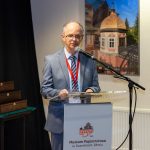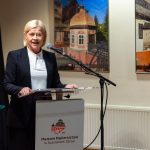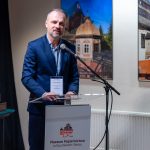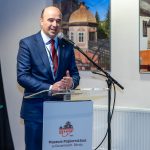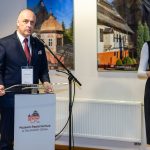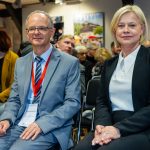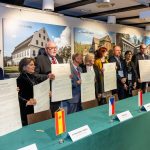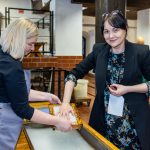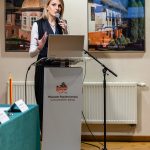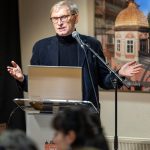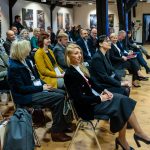Conference European Paper Mills from the Era of Hand-made Paper – International Project of Inscription on the UNESCO World Heritage List
On Tuesday, the 4th of March, our museum hosted an international conference of the utmost importance: „European Paper Mills from the Era of Hand-made Paper”. It had been organised by our institution in collaboration with the Department of Monument Protection at the Ministry of Culture and National Heritage and supported by the Office of the Marshal of the Lower Silesian Voivodeship, as well as by the European Grouping of Territorial Cooperation NOVUM. The topic of the event was the inscription of the historic paper mills on the UNESCO World Heritage List.
According to Bożena Żelazowska, the secretary of state at the Ministry of Culture and National Heritage, the encounter in Duszniki proved that the international cooperation based on passion and commitment, may bear real fruit. In fact, the joint endeavour to preserve Europe’s cultural heritage unites us beyond the geographical boundaries. The current lack of the European paper mills on the UNESCO World Heritage List constitutes as a serious gap in the history of civilisation, as paper has actually revolutionised the access to knowledge and communication. The historic paper mills may be considered as unique witnesses of the pre-industrial production methods. Hence, the initiative taken by the states in order to give effective protection to this part of the European heritage and to promote the universal cultural values which they represent, is all the more valuable.
Jarosław Rabczenko – member of the Board of the Lower Silesian Voivodeship – emphasized that the idea to inscribe the European paper mills on the UNESCO World Heritage List, implemented on a regular basis by the Museum of Papermaking, enjoys extensive support of the board. In fact, , it is currently both the most advanced and the most elaborate project concerning the inscription on the UNESCO List not only in Lower Silesia, but also on a national scale. The nomination of the paper mill in Duszniki Zdrój to the inscription on the UNESCO List, shall also draw attention to the other elements of cultural heritage in Lower Silesia – the region which is caracterised by the largest concentration of historic sites in Poland. Maciej Szymczyk – director of the Museum of Papermaking – emphasized that out of many thousands of European paper mills which had been operating from the Middle Ages up to the 19th century, only about twenty have remained until our times. Therefore, the six most valuable of them deserve appropriate protection. He also recalled that the idea of inscription had been born almost ten years ago in the Museum of Papermaking. In the course of the following years it have been methodically implemented by this instidution, which managed to gain both the support of the Office of the Marshal of the Lower Silesian Voivodeship and the commitment of the Department of Monument Protection in the Polish Ministry of Culture and National Heritage.
Professor Bogusław Szmygin – the president of ICOMOS Poland – stated that the project coordinated by the Museum of Papermaking is overly complicated and the cooperation with five foreign institutions requires a great commitment. All the actions shall be taken jointly, due to the international character of the venture. However, the future success will deliver benefits not only to the Museum of Papermaking, but also for Poland as a whole. The experience gained through this initiative will be an asset for the implementation of other international projects in the future.
The conference was attended by the representatives of the ministries, in charge of the the UNESCO affairs from the five countries – partners to the project. The Polish party was represented by a delegation led by Bożena Żelazowska – secretary of state at the Ministry of Culture and National Heritage. The Czech delegation was led by Dita Limová – Head of UNESCO Affairs Unit in the Ministry of Culture of the Czech Republic. Germany was represented by Friederike Hansell from the Federal Ministry of Foreign Affairs, and Spain – by Laura Demiguel from the Ministry of Culture and Sport of the Kingdom of Spain. The representatives of the Italian Ministry of Culture took part in the conference remotely. Apart from this, the conference was also attended by the representatives of other institutions, such as: Narodowy Instytut Dziedzictwa, Národní památkový ústav from the Czech Republic, authorities responsible for the conservation and restoration of monuments from the Lower Silesia and Saxony, members of the grouping EUWT NOVUM, local government officials and the representatives of the European paper mills which form the future nomination group.
The conference was aimed above all at sealing of the multilateral cooperation within the project, which is managed under the Polish leadership. In fact, the Republic of Poland undertook the overall management of the project, whereas the Museum of Papermaking assumed the role of a coordinator as far as the the multilateral cooperation between the respective paper mills is concerned. At the same time, the rules of cooperation have been defined in the agreement which was signed during the conference by the representatives of the six paper mills involved in the project: Maciej Szymczyk (Duszniki-Zdrój), Pavel Šoch (Velké Losiny), Johannes Follmer (Homburg), Paula Stötzer (Niederzwönitz), Victòria Rabal i Merola (Capellades), Massimiliano Bini (Pescia).
Before lunch the guests visited the most important parts of the exhibition in the Museum of Papermaking. The guided tour was followed by traditional hand papermaking workshops, with a special element, i.e. making sheets of paper with the handprints of the guests. The guests also did not forget to leave their records in the Visitors’ Book of the Museum.
The second part of the conference was started in the afternoon, with a lecture on the architecture of the paper mills, given by Emilia Dziewiecka PhD from the Museum of Papermaking,. It was followed by the deliberations conducted by professor Bogusław Szmygin who presides the Polish ICOMOS Committee. This part of the conference actually focused on the questions concerning the preparation of documentation, which is required by the World Heritage Centre for the application concerning the inscription on the UNESCO World Heritage List.
On the following day, the participants of the conference went to Velké Losiny in Czech Republic, for a study visit in the local paper mill which is one of the sites included in the future nomination.


